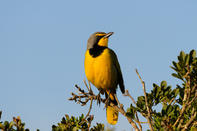
Name
Bokmakierie - Telophorus zeylonus
Bokmakierie Appearance
The bokmakierie is a bushshrike around 23 cm in length. The bokmakierie has olive-green underparts, with a bright yellow tip on its black tail.
The head is grey with a yellow eyebrow or supercilium. A broad black collar separates the breast from the throat. The back and wings are an olive green. The bill is black and the upper mandible has a hook on the end. The legs and feet are grey.
Diet
The bokmakierie has a diet made up mostly of insects, but will prey on snails, birds, amphibians, small reptiles and sometimes fruit.
Bokmakierie Breeding
A bowl-shaped cup of twigs and plant matter are built by both birds in a well concealed bush or tree. Two to five eggs are laid and the male will incubate during the day, with the female doing the incubating at night. Incubation takes around 17 days.
The chicks are fed by both parents and will leave the nest around 21 days later. The chicks will often stay in the parent's territory until the next batch of eggs, when they will then be chased away.
Bokmakierie Behaviour
The bokmakierie is a secretive bird and is more often heard than seen. Its most common call is “bok-bok-mak-kik”, the origin of its common name. This bushshrike will often call or sing in “duet”. Bokmakieries are not gregarious and are normally found singly or in pairs.
Threats
None.
Bokmakierie Distribution and Habitat
The bokmakierie is near endemic and is found throughout South Africa. It is most common in the Karoo and fynbos areas. It is also frequently found in parks and gardens.